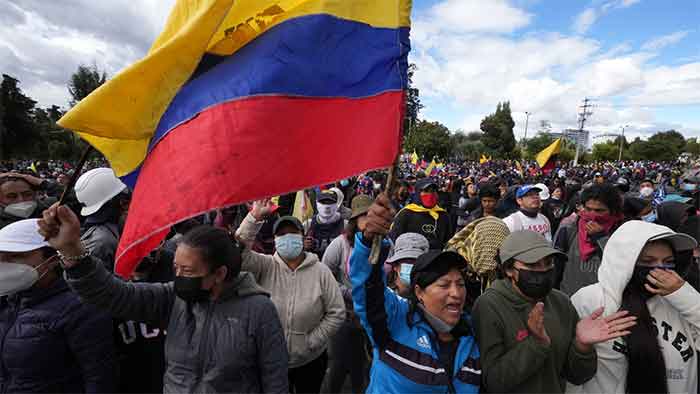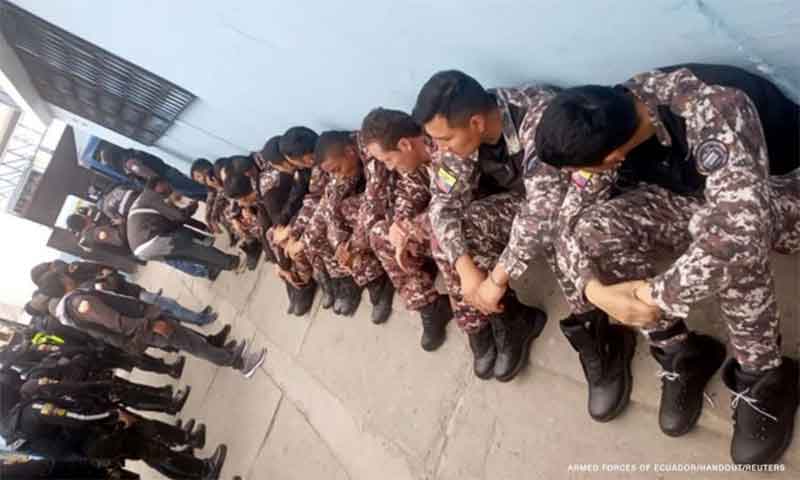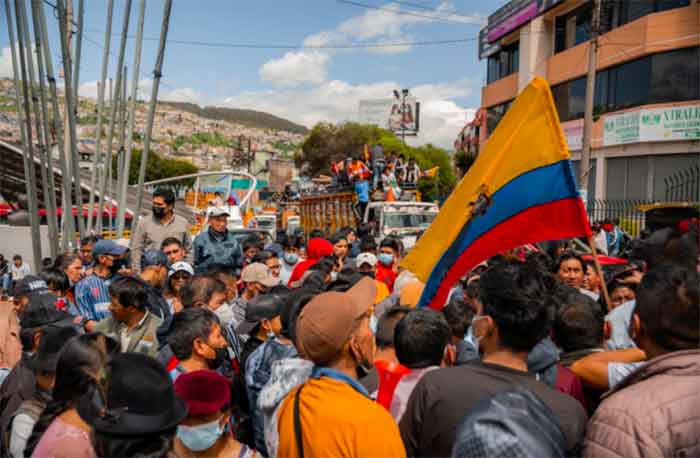
The national strike in Ecuador, which ended on Thursday, June 30, is presented as a struggle for the collective rights of peoples and nationalities and as a new popular confrontation against neoliberal policies.
The movement can be seen as a show of the strength, organization and expression of the different progressive social forces in Ecuador. The class struggle and the battle for the rights of peoples and nationalities in the country has a long history and will continue in the future too.
Among the many interesting and significant aspects of the national strike, some are listed below. These aspects have been present throughout the 18 days of the National Strike and were critical to forcing the government to sit down and give in to the protestors.
The brutal repression
Six days into the national strike on Sunday, June 19, Guillermo Lasso, the President of Ecuador, appeared in military dress in a clear signal of his militarist approach to the demands of the people – one characteristic of the right wing. Repression would be the norm.
At the moment, officially only five deaths have been recognized among the protesters, with at least one case that may constitute an extrajudicial execution as per the criteria of prominent Human Rights organizations. There is also a death from the military ranks, of a soldier of peasant origin, in a case that deserves investigation due to the very different accounts of how it happened that are presented.
The lives of six other people have been cut short in this period due the lack of a solution to unemployment and poverty. There will be six families in Ecuador who will keep these days in their memory for their entire lives.
The confrontations between protestors and security forces have been strong on some occasions and places. On the one hand, it can be said in general that when police or military forces do not appear with orders to stop the marches, they have been peaceful and have listened to the calls of their leaders to avoid any action that could discredit the struggle. On the other hand, the protests have been repressed in ways not seen even in the 2019 uprising in which there are members of the then government accused of crimes against humanity. This time police even invaded and took over the prestigious House of Culture in Quito, attacked universities that acted as centers of refuge and peace and brutalised defenceless people.
The protestors too burned down two Police Units but even the police representative admitted that this was due to the reaction of an angry crowd agitated by the false news of the death of a child in the protests and done in the midst of repression of the community at night. Unlike the claim of the Lasso government it was not about ‘planned violent actions’ and even less about the presence of “urban guerrillas”, and more about human and collective reactions of a people fed up with the State and those who exercise authority ignoring popular demands.
Since Leonidas Iza, president of CONAIE, (the main indigenous organisation leading the national strike), was arrested on June 14, the popular forces have unified even more and intensified the struggle. Across all the provinces of the country more and more participants joined the protests, with their own agendas and claims, such as the public transporters in various places, upset that their demands and negotiations with the regime have not been respected by the government.
The police and military violence, of which there are numerous testimonies and films, led to talk of possibility of a massacre. Surely, the number of wounded and their conditions suggests that the total number of fatalities could be higher than official claims.
The government was forced to yield
The conditions in which the struggle grew and the economy was paralyzed, showed that the government could not control the situation or stop the protests, adding to its discredit and political weakness, and leading it to a dead end.
For this reason, Lasso made announcements in response to popular demands that included:
- Increasing the human development bond from $50 to $55, which represents an increase of $30 million this year and $60 million the next towards social welfare programs;.
- Provision of subsidies for purchasing urea for at least 100,000 producers, which will cost some $27 million;
- Waiver of debts owed by peasants to BanEcuador of up to $3,000.
- Increase in allocation for budgets for education and health, as demanded by the protest leaders.
- Agricultural credit of up to $5,000 at 1% interest and over a 30-year term;
- No rise in diesel, gas and gasoline prices; and
- No privatization of public services and strategic sectors of the economy.
Although insufficient and without operational definitions, they constituted the first victory of the strike. A little later, the government decided to lower the price of fuel by 10 cents of a dollar per gallon and also announced the sale a cooking oil at a 20% lower price.
The President was also forced to finally sit down to negotiate with the indigenous leaders. The evidence that the strike would continue and was going to gain new strength, plus the mediation of the Catholic Church, left him with no choice. In the last round of meetings with protest leaders, on Thursday June 30, a further set of demands had to be accepted by the government, including:
- An additional reduction of 5 cents (total 15 cents) on fuel;
- The repeal of a newly introduced oil policy;
- Important reforms to the national policy on mining policy;
- Assurance of prior consultation with indigenous communities and peoples and nationalities on major policies;
- Reform of the law to ensure that greater share of revenues from oil resources are distributed in the Amazon region, from where the resource is extracted.
The results, if added up, are very important and show that State repression was not enough to give the government the upper hand against the protesting citizens with their war cry “Fuera Lasso!’ or “Get out, Lasso.”
Conclusion
The popular victory after 18 days of strike does not imply an end point in the social struggle. In the particular conditions of Ecuador, it is another chapter in the long march to create a popular government. If the movement grows and is organizationally well structured, the hopes of achieving it will materialize in a shorter period of time.
Meanwhile, the indigenous organizations of Ecuador are maintaining vigilance to achieve compliance with the agreements that the government has signed. They demanded a dialogue and obtained clear results and for this reason they cannot be mocked today anymore.
The victory is indigenous and popular, economic, political and ideological, and this provides the basis for deepening the popular struggle on all these levels.
Edgar Isch is an academic and former Minister of the Environment of Ecuador. He is currently associated with the Latin American Center for Strategic Analysis (CLAE)















































